Stories
Nautical Style
Late 1800s -

The adaptation of nautical dress for women’s fashion is a recurring trend. The fascination with sailor-style that began in the late 19th century continues to this day.
Main components of the look - naval officers’ brass buttoned navy or white jackets, epaulettes and gold braid, and the naval ratings’ bellbottom trousers, square-collared middy blouses and navy and white Breton-striped tops - have avoided becoming a cliché by being reinterpreted afresh every few years by different designers for different generations.
A look through the historic photo archives held by various New Zealand institutions reveals nautically-inspired fashions dating back to the late 1800s. Influenced by the Princess of Wales, later Queen Alexandra, who wore yachting gowns with nautical details, New Zealand women adopted the style, often in the form of a sailor blouse and long skirt, for tennis, beach outings and picnics.
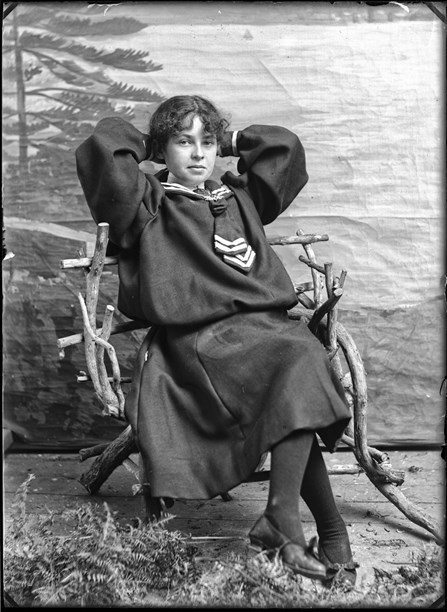
Portrait of Aileen Enwright wearing a sailor dress, February 1900. Photo by Charles Peet Dawes, courtesy of Auckland Libraries Heritage Collections, 1142-D159. No Known Copyright.
Because Alexandra was considered an arbiter of fashion, the NZ Graphic and Ladies Journal, the society weekly magazine dedicated to preserving the English way of life in this country, encouraged colonial women to follow her lead and have copies of the dresses made for themselves and their daughters.
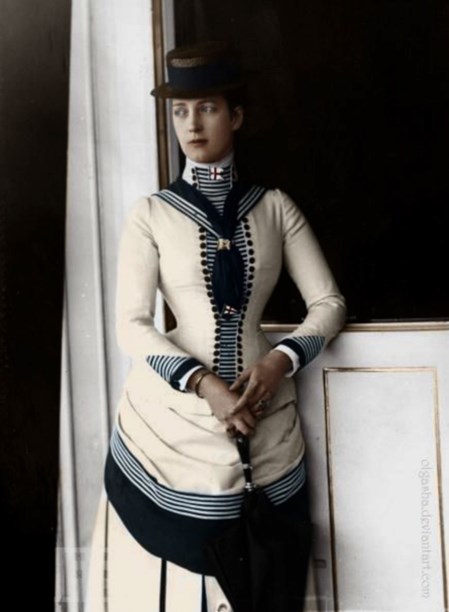
Alexandra, Princess of Wales wears a yachting gown with nautical details. Late 1800s.
Archival photographs illustrate that sailor-suits were also favoured for boys. In 1916, Auckland department store Smith & Caughey’s advertised sailor-suits, complete with whistle and lanyard, in their autumn/winter catalogue.

Boy’s sailor-suit, Smith & Caughey’s catalogue, 1916.
Sailor-suits were later adapted as dresses for little girls and versions thereof remained popular for decades.
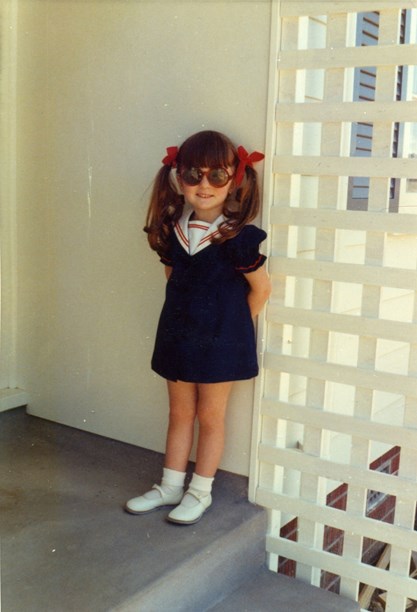
Three-year-old Emma Geary photographed in Auckland in 1972 wearing a button-through sailor dress made from a Little Vogue pattern.
Chanel is credited with popularising the classic Breton-stripe top or marinière, which she herself wore with wide-leg pants, and incorporated in her 1917 collection. Possibly the most recognisable item of sailor-chic, this navy and white boat-neck garment, designed to wear under a middy (midshipman) blouse, was introduced in 1858 as part of the French Navy uniform and is still worn today. Originally, it had 21 stripes, equating to the number of Napoleon’s victories. The stripes were also intended to make a sailor more visible if he fell overboard.
Two or three generations later, another French designer Jean Paul Gaultier adopted the Breton-stripe as a signature of sorts. He has included it in his collections for over 40 years. The bottle for his men’s fragrance, Le Male, wears a Breton t-shirt and the animated figure of Gaultier which opened the 2011 exhibition, The Fashion World of Jean Paul Gaultier; From the Sidewalk to the Catwalk, wore a marinière in angora wool with a tartan kilt.
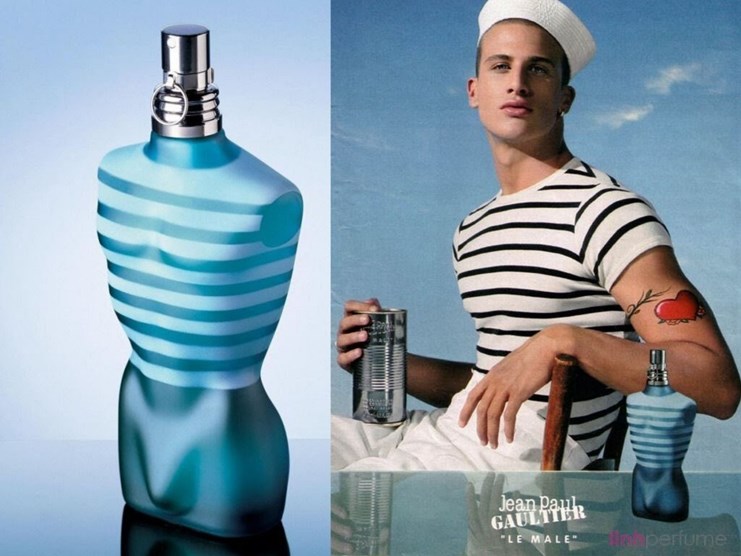
Jean Paul Gaultier Le Male. The fragrance, which launched in 1995, arrived in New Zealand the following year.
Nautical fashion in the 1980s and early 1990s tended to evoke the leisure classes at play in the 1920s on the French Riviera and in Deauville, the Normandy seaside resort where Chanel opened her first shop in 1913. Long white jackets with brass buttons worn over languid white dresses or ankle-grazing, pleated white skirts, and elongated middy tops with blue-trimmed sailor collars were among the somewhat romanticised renderings of the period. It was this look that Trelise Cooper tapped into for the sailor-collared jackets and dresses she designed for her 1987 summer collection.

Nautically-inspired jacket, skirt and dress from Trelise Cooper collection, Summer 1987.
In the 1990 Corbans Fashion Collections, the nautical theme was picked up by Dreamgirls, Peppertree and L’Officiel. Dreamgirls references were subtly nuanced, relying on crisp shoulder-lapping collars, wide-leg pants, pleated culottes and the colours navy and white to recreate the Riviera/Deauville style.
Accessorised with white gloves and white straw hats with turn-back brims, Peppertree’s white-trimmed, calf-length navy dresses combined aspects of the French sailor and the French schoolgirl. Mademoiselle meets matelot with oodles of Gallic charm.

Peppertree dress, buttoned from neck to hem and pleated below the hip. Corbans Fashion Collections 1990.
The look from L’Officiel was more eclectic, a little bit Royal Navy, a little bit French matelot, a little bit Chanel. To the strains of Edith Piaf, models sailed down the runway in navy and white striped dresses, sailor-collared white shirts and Chanel-style cardigans and tops with gold buttons and Breton-stripe detail.
Variations on a nautical theme by L’Officiel. Corbans Fashion Collections 1990.
One of the most memorable local salutes to the nautical look in print was a ten-page spread in Fashion Quarterly, styled by fashion editor Katarina Williams and photographed by Alistair Guthrie in 1992. Courtesy of the Royal New Zealand Navy, readers were welcomed aboard HMNZS Waikato in Devonport where models dressed by Barbara Lee, Hero, Moontide, A.B.S California, Ashley Fogel, Chrissy R and Adrienne Winkelmann, posed with officers and members of the crew. Captioned 'Anchors Aweigh. Ship shapes in red, white or blue are among the season’s smartest recruits', the spread featured variations on the officer’s brass-buttoned jacket, wide pants, bodysuits, shorts, singlets, split skirts with gold button trim – and a plethora of stripes. Shooting in this location provided a fitting backdrop for the garments and a tangible link to their origins.
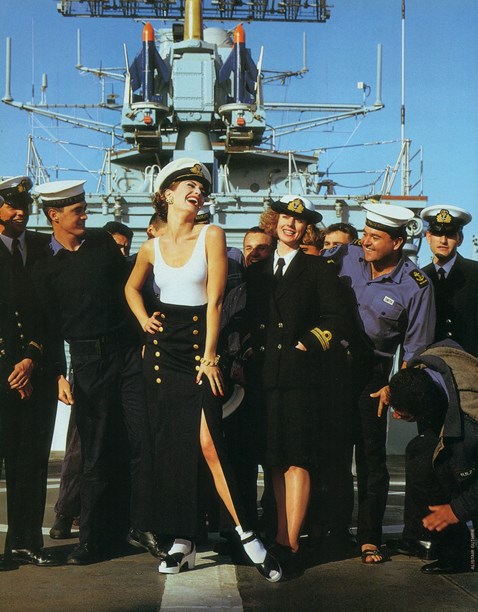
Photo shoot for Fashion Quarterly, HMNZS Waikato, Devonport, Auckland, Summer 1992.
In 1993, Ashley Fogel, Country Road, Jag and Suzanne Gregory took navy and white stripes of varying widths as their theme. They worked them into laid-back nautical looks featuring loose jackets, long tubular t-shirt dresses and midriff-baring cropped knit tops paired with navy blue waistcoats, brass-buttoned bellbottoms (now referred to as 'flares') and long-line sleeveless coats.
For their 2015 summer collections, Trelise Cooper, Karen Walker, Kate Sylvester and WORLD designed dresses, play-clothes and wide-leg pants with a nautical spin. While they didn’t go overboard for naval design details, their use of stripes and a colour theme of blue and white with a dash of red authenticated the look.
Trelise Cooper, who often makes nautical references in her collections, says she loves the look because it is timeless. "Being navy and white, it always looks fresh and contemporary and the addition of braids, tapes, gold buttons or embroidered crests gives it an elegant je ne sais quoi."
One nautical garment that never changes or goes out of style is the double-breasted wool pea coat traditionally worn by sailors in the British and US navies and popularised as a fashion item by Yves Saint Laurent in his autumn/winter couture collection in 1962. Cut to just above the knee, with short length broad lapels, metal buttons and vertical or slash pockets, the pea coat was originally navy blue but today it can be any colour, often black. Auckland designer Liz Mitchell has been producing pure wool pea coats for many years and still makes them to order. Beth Ellery has included a variant as a jacket and a coat in her 2018 winter collection and titled them Heirloom to denote their timelessness.
On her visit to New Zealand with Prince William and Prince George in 2014, Kate Middleton, Duchess of Cambridge, was pictured wearing a navy blue blazer with two rows of gold buttons and a Breton-stripe top. Photographs of her taken in England, on the royal round, show her dressed in other nautically-inspired separates, dresses and coats.
It is interesting to note that it was another queen-in-waiting, Alexandra Princess of Wales, whose yachting gowns captured the public’s imagination all those years ago and started what was to become one of fashion’s most enduring trends.
Text by Cecilie Geary. Banner image of a sketch by Warden Neil for Alta Moda.
First published March 2018, updated May 2020.